Related Research Articles
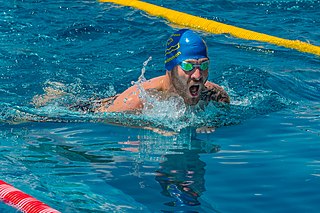
Swimming is the self-propulsion of a person through water, or other liquid, usually for recreation, sport, exercise, or survival. Locomotion is achieved through coordinated movement of the limbs and the body to achieve hydrodynamic thrust that results in directional motion. Humans can hold their breath underwater and undertake rudimentary locomotive swimming within weeks of birth, as a survival response. Swimming requires stamina, skills, and proper technique.

A swimsuit is an item of clothing designed to be worn by people engaging in a water-based activity or water sports, such as swimming, diving and surfing, or sun-orientated activities, such as sun bathing. Different types may be worn by men, women, and children. A swimsuit can be described by various names, some of which are used only in particular locations or for particular types of suit, including swimwear, bathing suit, bathing attire, swimming costume, bathing costume, swimming suit, swimmers, swimming togs, bathers, cossie, or swimming trunks, besides others.
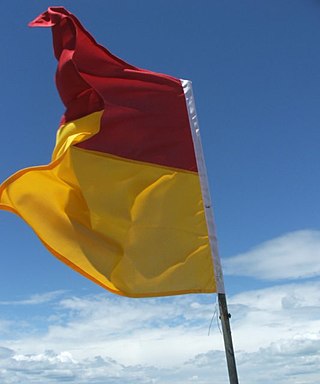
A lifeguard is a rescuer who supervises the safety and rescue of swimmers, surfers, and other water sports participants such as in a swimming pool, water park, beach, spa, river and lake. Lifeguards are trained in swimming and CPR/AED first aid, certified in water rescue using a variety of aids and equipment depending on requirements of their particular venue. In some areas, lifeguards are part of the emergency services system to incidents and in some communities, lifeguards may function as the primary EMS provider.
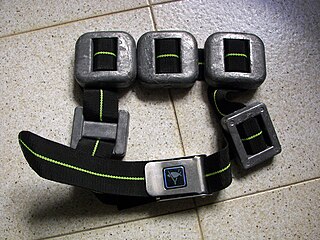
A diving weighting system is ballast weight added to a diver or diving equipment to counteract excess buoyancy. They may be used by divers or on equipment such as diving bells, submersibles or camera housings.
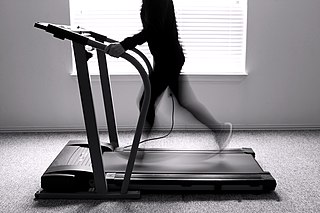
A treadmill is a device generally used for walking, running, or climbing while staying in the same place. Treadmills were introduced before the development of powered machines to harness the power of animals or humans to do work, often a type of mill operated by a person or animal treading the steps of a treadwheel to grind grain. In later times, treadmills were used as punishment devices for people sentenced to hard labour in prisons. The terms treadmill and treadwheel were used interchangeably for the power and punishment mechanisms.
Due to the nature of triathlons as a race consisting of multiple sports many pieces of technical equipment have been borrowed from other sports, or developed specifically in an effort to race faster and improve a competitors safety.

Competitive swimwear refers to the swimsuit, clothing, equipment, and accessories used in the aquatic sports of swimming, diving, synchronized swimming, triathlon, and water polo.
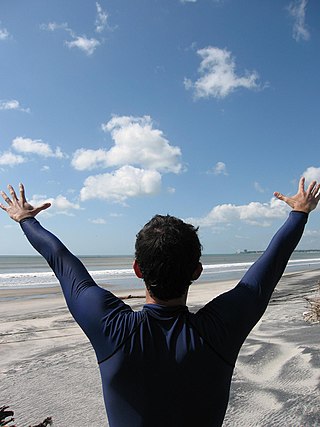
A rash guard, also known as rash vest or rashie, is an athletic shirt made of spandex and nylon or polyester. The name rash guard reflects the fact that the shirt protects the wearer against rashes caused by abrasion, or by sunburn from extended exposure to the sun, as sun protective clothing.
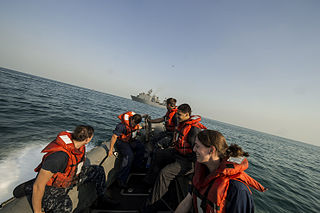
A personal flotation device is a flotation device in the form of a vest or suit that is worn by a user to prevent the wearer from drowning in a body of water. The device will keep the wearer afloat with their head and mouth above the surface – they do not have to swim or tread water in order to stay afloat and can even be unconscious.
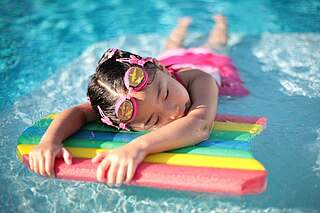
A swimming float, commonly known as pool float or floaty, is a device used for toddlers or other very young children who are beginning to learn how to swim, or during exercise for therapeutic or training purposes. These devices, which come in many shapes and types, are used to aid them with buoyancy, or for floating on for fun.

Open water swimming is a swimming discipline which takes place in outdoor bodies of water such as open oceans, lakes, and rivers. Competitive open water swimming is governed by the International Swimming Federation, World Aquatics, except when it is part of multi-sport events, which are governed by the World Triathlon.

Inflatable armbands, usually referred to as simply armbands, water wings, swimmies, or floaties, are swim aids designed to help a wearer float in water and learn to swim.
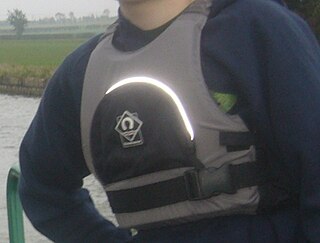
Buoyancy aids are a specialist form of personal flotation device (PFD) used most commonly by kayakers, canoeists, people practicing rafting, and dinghy sailors. They are designed as a flotation aid, rather than merely a life-saving device and have several key differences to other PFD's and lifejackets. Some buoyancy aids may not provide the same high level of protection as lifejackets.
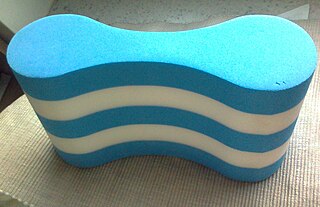
A pull buoy or leg float is a figure-eight shaped piece of closed-cell foam used in swim workouts. Swimmers place the buoy between their thighs or their ankles to provide support to the body without kicking their legs; this allows the swimmer to focus on training only their arms and developing both endurance and upper body strength.
Aquatic therapy refers to treatments and exercises performed in water for relaxation, fitness, physical rehabilitation, and other therapeutic benefit. Typically a qualified aquatic therapist gives constant attendance to a person receiving treatment in a heated therapy pool. Aquatic therapy techniques include Ai Chi, Aqua Running, Bad Ragaz Ring Method, Burdenko Method, Halliwick, Watsu, and other aquatic bodywork forms. Therapeutic applications include neurological disorders, spine pain, musculoskeletal pain, postoperative orthopedic rehabilitation, pediatric disabilities, pressure ulcers, and disease conditions, such as osteoporosis.
The Halliwick Concept focuses on biophysical principles of motor control in water, in particular developing sense of balance (equilibrioception) and core stability. The Halliwick Ten-Point-Programme implements the concept in a progressive programme of mental adjustment, disengagement, and development of motor control, with an emphasis on rotational control, and applies the programme to teach physically disabled people balance control, swimming, and independence. Halliwick Aquatic Therapy, implements the concept in patient-specific aquatic therapy for application in rehabilitation of injury and disability.
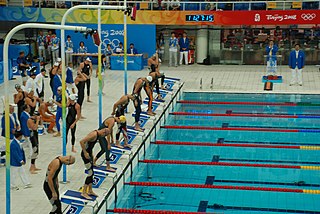
Swimming is an individual or team racing sport that requires the use of one's entire body to move through water. The sport takes place in pools or open water. Competitive swimming is one of the most popular Olympic sports, with varied distance events in butterfly, backstroke, breaststroke, freestyle, and individual medley. In addition to these individual events, four swimmers can take part in either a freestyle or medley relay. A medley relay consists of four swimmers who will each swim a different stroke, ordered as backstroke, breaststroke, butterfly and freestyle.

The front crawl or forward crawl, also known as the Australian crawl or American crawl, is a swimming stroke usually regarded as the fastest of the four front primary strokes. As such, the front crawl stroke is almost universally used during a freestyle swimming competition, and hence freestyle is used metonymically for the front crawl. It is one of two long axis strokes, the other one being the backstroke. Unlike the backstroke, the butterfly stroke, and the breaststroke, the front crawl is not regulated by the FINA. Hence, in "freestyle" competitive swimming events, any stroke or combination of strokes is permissible. This style is sometimes referred to as the Australian crawl although this can sometimes refer to a more specific variant of front crawl.
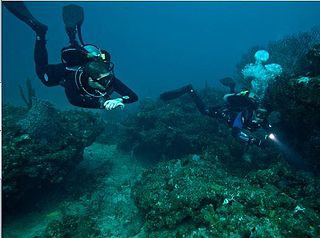
The trim of a diver is the orientation of the body in the water, determined by posture and the distribution of weight and volume along the body and equipment, as well as by any other forces acting on the diver. Both static trim and its stability affect the convenience and safety of the diver while under water and at the surface. Midwater trim is usually considered at approximately neutral buoyancy for a swimming scuba diver, and neutral buoyancy is necessary for efficient maneuvering at constant depth, but surface trim may be at significant positive buoyancy to keep the head above water.
References
- ↑ Shelley, Jake. "Aquajogging: how, when and why to try it" . Retrieved 30 April 2019.
- ↑ Burdick, Allie. "Aqua Jogging - Lessons Learned". Runner's World.
- ↑ Davis, John. "3 Scientifically Supported Tips to Help You Get the Most out of Pool Running: The Latest Research". Runners Connect. Retrieved 30 April 2019.
- ↑ Anttila, Eevaliisa (2005). Vesijuoksijan käsikirja. Helsinki: Edita. ISBN 951-37-4322-5. OCLC 76851700.
- ↑ Dooney, Emma. "What is aquajogging and why is it good for runners?". Runner's World.